File:Early Medieval bead (FindID 611910).jpg

Original file (2,168 × 2,094 pixels, file size: 1.29 MB, MIME type: image/jpeg)
Captions
Captions
Summary
[edit]| Early Medieval bead | |||
|---|---|---|---|
| Photographer |
Somerset County Council, Laura Burnett, 2014-04-17 13:59:22 |
||
| Title |
Early Medieval bead |
||
| Description |
English: Translucent blue-green glass bead with an opaque white-yellow trail, probably Late Iron Age to early Roman in date of Guido (1978) Class 11. The bead is slightly oval in plan, barrel shaped in profile with flat ends and convex curved sides. It has a square hole through the centre, distinctly larger at one side than the other (5.5 by 5mm compared to 4 by 3.6mm). It is a pale translucent green-blue colour. A trail of white-yellow opaque glass has been laid on the outside in a series of broad U shaped loops and then combed with a line drawn around the centre of the side creating a rounded M shape. The trial has been marvelled flat but in places the opaque glass has not adhered well to the glass underneath and is coming away. The central hole is slightly off centre and the thickness is irregular. It is 14.5mm by 13.5mm externally and 7.7mm thick, it weighs 1.90 grams.
Colourless glass beads with yellow opaque decoration were found, and produced, at the lake villages of Meare (Coles 1987) and Glastonbury, dating to the late Iron Age (300-1 BC). The blue green base of the bead and the exact form of the decoration in not paralleled at Meare East (Coles ibid:81-5). An example with a 'herringbone' design' although lacking the central line is known from Meare West (Grey 1966::289, no.G14) where plain translucent blue-green glass beads were also found (ibid:290). The square central hole may also suggest a different production technique and therefore source. |
||
| Depicted place | (County of findspot) Somerset | ||
| Date | between 300 BC and 200 | ||
| Accession number |
FindID: 611910 Old ref: SOM-FCF621 Filename: SOM-FCF621.JPG |
||
| Credit line |
|
||
| Source |
https://finds.org.uk/database/ajax/download/id/465078 Catalog: https://finds.org.uk/database/images/image/id/465078/recordtype/artefacts archive copy at the Wayback Machine Artefact: https://finds.org.uk/database/artefacts/record/id/611910 |
||
| Permission (Reusing this file) |
Attribution-ShareAlike License version 4.0 (verified 13 November 2020) | ||
Licensing
[edit]- You are free:
- to share – to copy, distribute and transmit the work
- to remix – to adapt the work
- Under the following conditions:
- attribution – You must give appropriate credit, provide a link to the license, and indicate if changes were made. You may do so in any reasonable manner, but not in any way that suggests the licensor endorses you or your use.
- share alike – If you remix, transform, or build upon the material, you must distribute your contributions under the same or compatible license as the original.
File history
Click on a date/time to view the file as it appeared at that time.
| Date/Time | Thumbnail | Dimensions | User | Comment | |
|---|---|---|---|---|---|
| current | 14:18, 24 January 2017 |  | 2,168 × 2,094 (1.29 MB) | Fæ (talk | contribs) | Portable Antiquities Scheme, SOM, FindID: 611910, early medieval, page 1721, batch count 655 |
You cannot overwrite this file.
File usage on Commons
The following page uses this file:
Metadata
This file contains additional information such as Exif metadata which may have been added by the digital camera, scanner, or software program used to create or digitize it. If the file has been modified from its original state, some details such as the timestamp may not fully reflect those of the original file. The timestamp is only as accurate as the clock in the camera, and it may be completely wrong.
| Camera manufacturer | Canon |
|---|---|
| Camera model | Canon EOS 350D DIGITAL |
| Author | unknown |
| Exposure time | 1/160 sec (0.00625) |
| F-number | f/32 |
| ISO speed rating | 200 |
| Date and time of data generation | 13:42, 4 April 2014 |
| Lens focal length | 60 mm |
| Orientation | Normal |
| Horizontal resolution | 240 dpi |
| Vertical resolution | 240 dpi |
| Software used | Adobe Photoshop CS2 Windows |
| File change date and time | 13:21, 17 April 2014 |
| Exposure Program | Manual |
| Exif version | 2.21 |
| Date and time of digitizing | 13:42, 4 April 2014 |
| APEX shutter speed | 7.321928 |
| APEX aperture | 10 |
| APEX exposure bias | 0 |
| Metering mode | Partial |
| Flash | Flash fired, compulsory flash firing |
| Color space | Uncalibrated |
| Focal plane X resolution | 3,954.233409611 |
| Focal plane Y resolution | 3,958.7628865979 |
| Focal plane resolution unit | inches |
| Custom image processing | Normal process |
| Exposure mode | Manual exposure |
| White balance | Manual white balance |
| Scene capture type | Standard |
| Image width | 2,168 px |
| Image height | 2,094 px |
| Serial number of camera | 1630702606 |
| Lens used | 60.0 mm |
| Owner of camera | unknown |
| Rating (out of 5) | 0 |
| Date metadata was last modified | 14:21, 17 April 2014 |
| IIM version | 2 |
